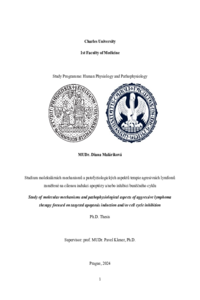Study of molecular mechanisms and pathophysiological aspects of aggressive lymphoma therapy focused on targeted apoptosis induction and/or cell cycle inhibition
Studium molekulárních mechanismů a patofyziologických aspektů terapie agresivních lymfomů zaměřené na cílenou indukci apoptózy a/nebo inhibici buněčného cyklu
dizertační práce (OBHÁJENO)

Zobrazit/
Trvalý odkaz
http://hdl.handle.net/20.500.11956/196510Identifikátory
SIS: 172185
Kolekce
- Kvalifikační práce [4588]
Autor
Vedoucí práce
Oponent práce
Pytlík, Robert
Mráz, Marek
Fakulta / součást
1. lékařská fakulta
Obor
Fyziologie a patofyziologie člověka
Katedra / ústav / klinika
Ústav patologické fyziologie 1. LF UK
Datum obhajoby
16. 1. 2025
Nakladatel
Univerzita Karlova, 1. lékařská fakultaJazyk
Angličtina
Známka
Prospěl/a
Klíčová slova (česky)
agresivní lymfom, palbociklib, venetoklax, inhibitory cyklin-dependentních kináz, BH3-mimetikaKlíčová slova (anglicky)
aggressive lymphoma, palbociclib, venetoclax, cyclin-dependent kinase inhibitors, BH3-mimeticsAgresivní podtypy B-non Hodgkinských lymfomů jsou charakterizovány deregulací buněčného cyklu a apoptózy z důvodu rekurentně se vyskytujících molekulárních a cytogenetických aberací, včetně zvýšené exprese D-cyklinů, amplifikace genů kódujících cyklin-dependentní kinázy a transkripční faktory (MYC), mutací a delecí důležitých regulátorů buněčného cyklu (RB1, TP53, CDKN2A) a aberantní exprese anti-apoptotických proteinů (BCL2). Společná inhibice cyklin-dependentní kinázy 4/6 palbociklibem spolu s inhibicí anti-apoptotických BCL2 proteinů pomocí BH3-mimetik (BCL2 inhibitor venetoklax, MCL1 inhibitor S63845 a BCL-XL inhibitor A11556463) představuje smysluplnou kombinaci pro léčbu B-NHL. Na experimenty bylo využito 20 buněčných linií lymfomu z buněk pláště a difúzního velkobuněčného lymfomu a 4 xenografty odvozené od pacientů s lymfomem buněk pláště po selhání chemoterapie či ibrutinibu, inhibitoru Brutonovy kinázy. Hladiny proteinů před a po léčbě byly stanoveny pomocí western blotu. Změny potenciálů na mitochondriální membráně a aktivita AKT byly změřeny JC-1 barvením a geneticky kódovaným fluorescentním AKT reportérem. Metabolické změny a náchylnost buněk k apoptóze před a po léčbě byli změřeny pomocí Seahorse XF analyzéru a BH3 profilování. Vybrané genetické aberace (mutace, genové delece či jiné aberace)...
Aggressive subtypes of B-cell non-Hodgkin lymphomas are characterized by deregulation of cell-cycle and apoptosis due to recurrent molecular and cytogenetic aberrations, including the overexpression of D-type cyclins, the amplification of cyclin-dependent kinases or transcription factors (MYC), mutations or deletions of important cell cycle regulators (RB1, TP53, CDKN2A) or the aberrant expression of anti-apoptotic proteins (BCL2). The combined inhibition of a cyclin-dependent kinase 4/6 by palbociclib and anti-apoptotic BCL2 proteins with respective BH3-mimetics represents reasonable treatment combination in experimental therapy of B- NHL. A panel of 20 mantle cell lymphoma (MCL) and diffuse large B-cell lymphoma (DLBCL) cell lines and 4 patient-derived xenograft (PDX) models derived from chemotherapy and/or ibrutinib-refractory MCL were used for in vitro and in vivo experiments, respectively. Protein levels before and after treatment were measured by western blotting. Changes in the mitochondrial membrane potential and activity of the AKT kinase were evaluated by JC-1 staining and a genetically encoded fluorescent AKT reporter (a fluorescence resonance energy transfer, FRET assay), respectively. Metabolic pathways and pro-apoptotic priming before and after exposure to the tested inhibitors were measured...
